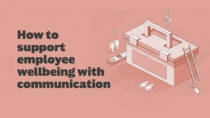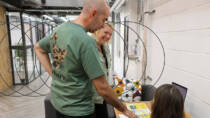Guide: How to support employee wellbeing with communication
By Sally Pritchett
CEO
Your shortcut to considered communication that supports employee wellbeing.
Whether it’s burnout, financial strain, chronic illness or mental health, the way we talk about wellbeing with employees makes a difference. The words we choose and the tone we set can either build trust – or come across as performative rather than supportive.
This guide is here to help. It offers practical advice for bringing a wellbeing lens to your communication so your messages feel thoughtful and rooted in care.
What’s inside:
-
Why poor communication can undermine wellbeing – even with good intentions
-
How to avoid overpromising, assumptions and unhelpful tone
-
Tips for writing with clarity, empathy and inclusivity
-
Language swaps that reduce stigma and help people feel seen
-
Advice for managers having sensitive conversations
-
Real-world examples to learn from
Who it’s for:
This guide is for anyone working in internal comms, HR, DEI or wellbeing – especially if you’re looking to strengthen your messaging, embed wellbeing into the everyday.
Download here: How to support employee wellbeing with communication
Download your screen reader–friendly guide below. Need help? Get in touch: hello@somethingbig.co.uk
PDF version
A PDF that can be read by a screen reader
8 things you probably didn’t know we do (some may surprise you)
By Sally Pritchett
CEO
We do more than strategic campaigns – here are eight ways we add unexpected value.
Our expertise is wide, and it often surprises people how much we do beyond delivering effective and inclusive creative communications. Here are eight areas where we add value in different, and sometimes unexpected, ways:
1. Naming
We create names with strategic clarity and long-term value. From naming strategies to creative options, we ensure names are credible, ownable and compelling. Whether it’s a new product, service or transformation project, names might seem like small details – but they play a big role in positioning and impact.
2. SharePoint
When employees can’t find what they need, productivity takes a hit. We design better SharePoint user experiences, making navigation clearer and information easier to access.
3. eLearning
We design and build eLearning modules, and output SCORM files, so you can bring more creativity to your team learning.
4. Gamification
From quizzes and competitions to interactive tools, we create gamified content that both informs and inspires employees – helping them engage with information in a memorable way.
5. Stakeholder management
We support leaders and comms teams to navigate complex stakeholder conversations, with practical advice and hands-on support when it’s needed most.
6. Strategic partnerships
Not ready to write a brief? We can act as a thinking partner, co-creating plans and shaping clear, effective briefs.
7. In-house team personal development
From creative inspiration sessions to proven systems that keep everything on track, we can share our experience built from over 25 years running a creative service, helping in-house teams to grow their capability and confidence.
8. Building better business cases
Budgets are harder than ever to secure. Using behavioural psychology techniques, we can help you build stronger business cases that shift the focus from cost to value.
Join our Building Better Business Cases masterclass on 23 October. Exclusive to Builder tier and above Work Wonders members. Find out more about membership here.
How we can work together
We partner flexibly, adapting to what you need:
- Activator – Got a story to tell? We simplify complex ideas and shape campaigns that bring everyone with you. Book a call
- Pathfinder – Need direction but limited budget? Join our Work Wonders community for guides, tools and events. Join Work Wonders
- Co-creator – Need a fresh perspective? We work alongside you to bring energy and insight. Talk to us
Is your impact report telling the right story for your charity?
By Sally Pritchett
CEO
If your impact report doesn’t connect with your audience, you’re missing the chance to build trust and support.
Annual impact reports are meant to show progress, inspire trust and make the case for continued support. But too often, they turn into a long list of activities – everything you’ve done, said or funded – without focusing on what really matters: what changed, and for who?
If you’re in charge of your charity’s yearly impact report, you already know the pressure. Multiple audiences. Competing priorities. A year’s worth of achievements. And just enough time to gather, write, design and publish. It’s no wonder so many reports end up as busy PDFs that few people truly engage with.
But a list of good things done isn’t the same as a story well told.
Data doesn’t speak for itself – but great report design can bring it to life
Strong report design helps visualise the numbers and pair them with human stories, so readers quickly see why your work matters.
Across the year, your charity might have delivered 36 workshops, supported 2,400 service users and trained 112 volunteers. But readers don’t just want to know the output. They want context, connection and a clear sense of how those activities made a difference.
That means:
- Highlighting the outcomes that matter most
- Pairing data or statistics with real human stories
- Stripping back anything that takes away from the story you want to tell
Put simply: don’t make people work to find the so what?
See your report as a communication tool
At its best, your impact report is an invitation for readers to better understand your mission, see the difference you’re making and feel part of the journey. It builds trust with funders, shows accountability to your community and helps stakeholders feel confident in where you’re headed.
That takes more than strong writing. Your report needs a structure that flows, visual hierarchy and inclusive, accessible language. A tone that’s confident but relatable. And a design that doesn’t just look good but also guides the reader through your achievements of the previous year.
When it’s done well, your impact report can:
- Strengthen future funding bids
- Unite teams around a shared purpose
- Turn complex work into compelling public stories
- Become something your CEO shares with pride – not just signs off
So how do you get there?
It starts by asking one simple question: “What do we want people to understand, feel and do when they read this report?” And then shaping the report around that – from the structure and copy to the design and visuals.
At Something Big, we help charities turn reports into stories worth telling. Whether you need help crafting the narrative, developing a meaningful visual concept or designing something people want to read, we’re here to help. Let’s talk about your next impact report.
Stop asking for budget – start showing the cost of doing nothing
By Sally Pritchett
CEO
The real question isn’t about the price of investing in culture – it’s about the cost of ignoring it.
You’ve spotted the signs. Motivation is low, good people are leaving, energy and performance are dropping off. You know your workplace culture needs attention – but when you raise it, there’s hesitation. Other priorities take precedence. Budget feels out of reach.
It’s a common pattern. Culture work is often seen as a nice-to-have or a long-term ambition, rather than a near-term need. But the reality? Failing to act costs far more than acting early. Poor workplace culture doesn’t just cost you engagement. It quietly drains your business, through absenteeism, turnover and underperformance.
And the impact runs deeper than many leaders realise.
The hidden cost of doing nothing
When culture starts to slide, the warning signs might not be instantly visible. But they show up clearly in business outcomes. Let’s look at just a few ways poor culture hits the bottom line:
- Employee disengagement is expensive. Gallup found that only 21% of employees worldwide feel engaged at work – costing the economy $438 billion in lost productivity.
- High turnover carries direct and indirect costs. From recruitment fees and lost knowledge to onboarding processes and the knock-on effect of team instability, the costs add up fast.
- Absenteeism tends to rise when people feel disconnected, unsupported or burned out.
- Poor performance becomes harder to challenge (and harder to turn around) when people stop caring and stop contributing.
However, all of this is avoidable. But not if work culture keeps being treated as a luxury.
Reframing the budget conversation
Instead of asking, “Can I have budget for culture?”, it’s time to flip the script. Ask: “Can we afford the cost of not investing?”
It’s a simple shift that changes the focus. It reframes culture not as an add-on, but as a performance risk. A retention risk. A strategic risk that deserves the same attention as any other. And it opens the door to a better conversation about ROI, because the return on employee engagement is real.
Investing in culture pays back in loyalty, energy, innovation and productivity. It helps people perform better, stay longer and care more. And that matters, because good people are hard to keep.
Time to move from instinct to insight
If your instinct is telling you something’s not right, trust it. But instinct alone won’t get the backing you need. That’s where diagnostics like THRIVE can help.
THRIVE helps you pinpoint exactly where culture is costing you – and where to focus your efforts for maximum impact. It takes the guesswork out of culture change, giving you a clear business case.
Because culture is never neutral. It’s either working for you or against you.
Ready to turn this into action?
Learn how to build a compelling case for culture investment by joining our Work Wonders Builder tier. You’ll get access to exclusive sessions, including our upcoming Building Better Business Cases masterclass on 23 October – packed with practical advice on how to secure support and funding for culture, comms and people initiatives.
Sign up to Work Wonders Builder tier today and get the insight and tools you need to make change happen.
Explore your workplace culture with THRIVE
By Sally Pritchett
CEO
Use our six diagnostics to explore how well your workplace culture and communication are supporting your people.
Exceptional workplace cultures don’t happen by chance – they’re built through intentional, inclusive and inspiring communication.
That’s why we created THRIVE – our methodology for building fairer, healthier and happier workplaces.
It’s based on six interconnected pillars that shape the everyday employee experience – from first contact to long-term belonging:
-
Talent – Attracting, developing and retaining people through authentic, honest and engaging employer brands.
-
Human – Bringing empathy, authenticity and emotional intelligence into the heart of the workplace.
-
Roadmap – Making strategy clear and meaningful so everyone knows where they’re heading and how they contribute.
-
Inclusion – Building a sense of inclusion and belonging that enables everyone to bring their true and best selves to work.
-
Values – Helping employees understand, believe in and live your organisational values.
-
Experience – Shaping the moments that matter, from onboarding to career milestones and beyond.
Each pillar plays a unique role in how employees feel about your organisation – and how engaged, connected and motivated they are day-to-day.
Quick diagnostics for THRIVE
We’ve built six quick, practical diagnostics – one for each THRIVE pillar. Each takes just a couple of minutes and gives you tailored insight into what’s working well, where there may be gaps, and how communication can help.
-
Talent Diagnostic: Is your EVP helping you keep the talent you’ve worked hard to hire?
-
Human Diagnostic: How well are you tuning in to your workforce?
-
Roadmap Diagnostic: Is your strategy really landing with your people?
-
Inclusion Diagnostic: How inclusive and accessible are your communications?
-
Values Diagnostic: Are your organisational values being heard and lived?
-
Experience Diagnostic: How well do your communications help shape the employee experience?
Whether you take one, a few, or all six, you’ll get tailored feedback and practical next steps to help strengthen your communication and employee experience.
Because when employees feel clear, connected and supported, great cultures don’t just survive – they thrive. And if the results show opportunities to improve, we’re here to help you take the next step.





